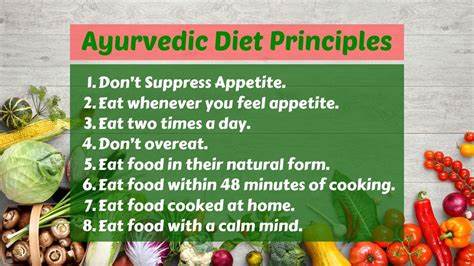This article illuminates the art of crafting a balanced Ayurvedic diet, guiding individuals in choosing foods that harmonize with their dominant dosha and foster overall wellness. Building a Balanced Ayurvedic Diet Know Your Dosha: To create a balanced Ayurvedic diet, you must first identify your dominant dosha – Vata, Pitta, or Kapha. This knowledge is
This article illuminates the art of crafting a balanced Ayurvedic diet, guiding individuals in choosing foods that harmonize with their dominant dosha and foster overall wellness.
Building a Balanced Ayurvedic Diet
- Know Your Dosha: To create a balanced Ayurvedic diet, you must first identify your dominant dosha – Vata, Pitta, or Kapha. This knowledge is the cornerstone of Ayurvedic nutrition.
- Understanding Dosha Qualities: Familiarize yourself with the qualities associated with your dosha, such as cold and dry (Vata), hot and intense (Pitta), or heavy and cool (Kapha).
https://www.appleadayrx.net/wp-content/uploads/2020/06/Yoga-and-Ayurveda.jpg
Tips for Balancing Your Ayurvedic Diet:
- Vata Diet Balance:
- Warm and Nourishing: Prioritize warm, nourishing foods to counteract Vata’s cold and dry tendencies.
- Root Vegetables: Incorporate root vegetables, grains, and warming spices like ginger and cinnamon.
- Moisture and Hydration: Maintain proper hydration and incorporate healthy fats like ghee.
- Pitta Diet Balance:
- Cooling Choices: Choose cooling foods to balance Pitta’s heat and intensity.
- Cucumbers and Melons: Include cucumbers, watermelon, and coconut in your diet.
- Bitter and Astringent Tastes: Favor foods with bitter and astringent tastes, like leafy greens and legumes.
- Kapha Diet Balance:
- Warming and Stimulating: Opt for warming, stimulating foods to counter Kapha’s coolness and heaviness.
- Pungent Spices: Incorporate pungent spices like ginger and black pepper.
- Light and Dry Qualities: Embrace lighter and drier qualities in your meals to counteract Kapha’s density.
Ayurvedic Meal Planning:
- Mindful Eating: Practice mindful eating to fully appreciate the taste, texture, and temperature of your food. Eat in a peaceful, calm environment.
- Proper Food Combining: Ayurveda offers guidelines for combining foods that promote better digestion and prevent imbalances.
- Seasonal Variations: Adjust your diet based on the seasons to maintain balance. For example, consume lighter, cooling foods in summer and warming, grounding foods in winter.
https://www.ayurtimes.com/wp-content/uploads/2019/06/Ayurvedic-Diet-Principles.jpg
Conclusion: Your Personal Path to Wellness
Crafting a balanced Ayurvedic diet is a personal journey to wellness and harmony. By selecting foods that align with your dominant dosha, you can foster inner equilibrium and enjoy the benefits of Ayurvedic nutrition.



















Leave a Comment
Your email address will not be published. Required fields are marked with *